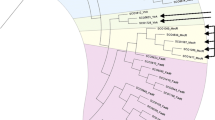Abstract.
Computational analysis of the hypothetical open reading frame MJ0236 from Methanococcus jannaschii reveals its membership to a family of bacterial and eukaryotic proteins, predicted to be the HMP-P kinases involved in thiamin biosyntheis (ThiD). The eukaryotic members of this family contain a C-terminal extension similar to a bacterial transcriptional activator (TenA), thus pointing to a fusion event that took place during cellular evolution. The C-terminal domain is absent from M. jannaschii. The significance of this observation is two-fold: first, this is a case where a fusion protein contains two domains with an unusual phylogenetic distribution, and second, the TenA domain is a rare case of a gene family involved in transcription present both in bacteria and eukaryotes.
Similar content being viewed by others
Author information
Authors and Affiliations
Additional information
Received: 14 January 1997 / Accepted: 5 June 1997
Rights and permissions
About this article
Cite this article
Ouzounis, C., Kyrpides, N. ThiD-TenA: A Gene Pair Fusion in Eukaryotes. J Mol Evol 45, 708–711 (1997). https://doi.org/10.1007/PL00013145
Issue Date:
DOI: https://doi.org/10.1007/PL00013145




